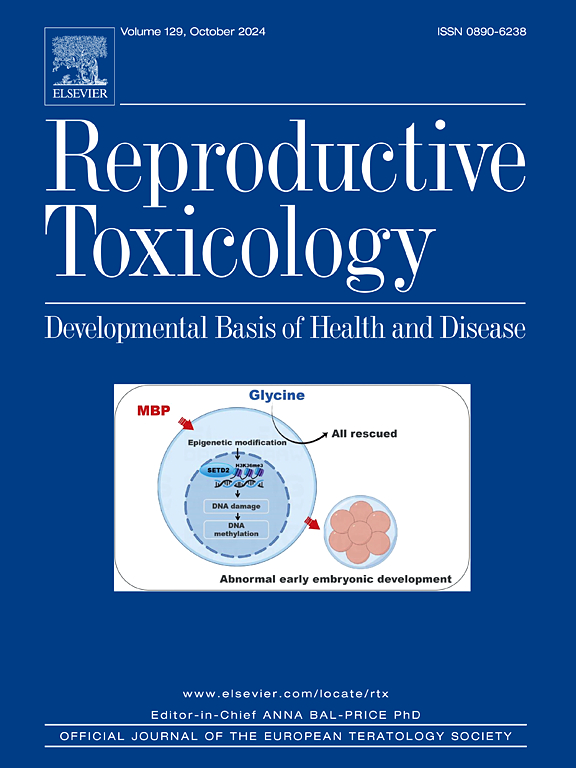双酚AF通过p53信号通路诱导TM3间质细胞周期阻滞和凋亡。
IF 3.3
4区 医学
Q2 REPRODUCTIVE BIOLOGY
引用次数: 0
摘要
双酚AF (BPAF)是最常见的双酚类似物之一,据报道,由于存在额外的疏水性基团,与双酚A (BPA)相比,双酚A具有更高的雌激素活性。为了全面了解BPAF的雄性生殖毒性,我们利用TM3间质细胞研究了BPAF对细胞增殖、凋亡和细胞周期阻滞的影响。通过对靶mRNA和蛋白表达的分析,探讨了BPAF诱导细胞反应的潜在机制。结果表明,BPAF处理降低了TM3间质细胞的细胞活力,诱导G2/M细胞周期阻滞和凋亡,并呈时间和剂量依赖性。RNA测序分析和实验验证进一步揭示了p53信号通路参与了bpaf诱导的细胞毒性。此外,p53抑制剂聚氟乙烯酯-α (PFT-α)可减轻bpaf诱导的G2/M细胞周期阻滞和凋亡。这些结果表明,p53信号通路介导BPAF诱导的间质细胞周期阻滞和凋亡,为BPAF对男性生殖系统的毒理学作用提供了机制见解。本文章由计算机程序翻译,如有差异,请以英文原文为准。
Bisphenol AF induces cell cycle arrest and apoptosis in TM3 Leydig cells via the p53 signaling pathway
Bisphenol AF (BPAF), one of the most common bisphenol analogues, has been reported to exhibit higher estrogenic activity compared to bisphenol A (BPA) due to the presence of additional hydrophobic groups. To comprehensively understand the male reproductive toxicity of BPAF, TM3 Leydig cells were used to investigate the effects of BPAF on cell proliferation, apoptosis, and cell cycle arrest. The underlying mechanisms of cellular responses induced by BPAF were examined through analysis of target mRNA and protein expression. Results showed that BPAF treatment reduced cell viability and induced both G2/M cell cycle arrest and apoptosis in a time- and dose-dependent manner in TM3 Leydig cells. RNA sequencing analysis and experimental verification further revealed that the p53 signaling pathway was involved in BPAF-induced cytotoxicity. Furthermore, Pifithrin-α (PFT-α), a p53 inhibitor, attenuated BPAF-induced G2/M cell cycle arrest and apoptosis. These results demonstrate that the p53 signaling pathway mediates BPAF-induced cell cycle arrest and apoptosis in Leydig cells, providing mechanistic insights into BPAF’s toxicological effects on the male reproductive system.
求助全文
通过发布文献求助,成功后即可免费获取论文全文。
去求助
来源期刊

Reproductive toxicology
生物-毒理学
CiteScore
6.50
自引率
3.00%
发文量
131
审稿时长
45 days
期刊介绍:
Drawing from a large number of disciplines, Reproductive Toxicology publishes timely, original research on the influence of chemical and physical agents on reproduction. Written by and for obstetricians, pediatricians, embryologists, teratologists, geneticists, toxicologists, andrologists, and others interested in detecting potential reproductive hazards, the journal is a forum for communication among researchers and practitioners. Articles focus on the application of in vitro, animal and clinical research to the practice of clinical medicine.
All aspects of reproduction are within the scope of Reproductive Toxicology, including the formation and maturation of male and female gametes, sexual function, the events surrounding the fusion of gametes and the development of the fertilized ovum, nourishment and transport of the conceptus within the genital tract, implantation, embryogenesis, intrauterine growth, placentation and placental function, parturition, lactation and neonatal survival. Adverse reproductive effects in males will be considered as significant as adverse effects occurring in females. To provide a balanced presentation of approaches, equal emphasis will be given to clinical and animal or in vitro work. Typical end points that will be studied by contributors include infertility, sexual dysfunction, spontaneous abortion, malformations, abnormal histogenesis, stillbirth, intrauterine growth retardation, prematurity, behavioral abnormalities, and perinatal mortality.
 求助内容:
求助内容: 应助结果提醒方式:
应助结果提醒方式:


